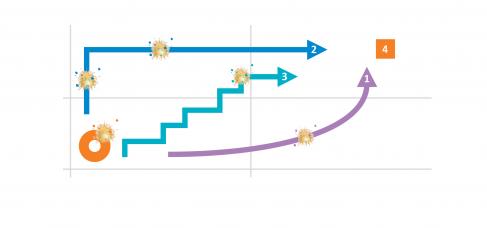In 2005 Bancolombia commenced a digital transformation that would alternate focus on improving customer experience and operations. Through 2014, the bank concentrated on unifying redundant technology platforms and replacing its banking core.
In 2015 bank leaders, who aimed for Bancolombia to be a customer-centric company, saw changes in customer expectations and behavior that suggested the bank was not achieving that ambition. The leaders invested in building a technical foundation that would enable the bank to enter into new business partnerships and support the development of ecosystems. Bancolombia began this work by strengthening the bank’s internal API layer, with the eventual goal of creating a robust external API layer, an API marketplace, or both. Focusing first on developing the internal API layer helped Bancolombia to isolate the bank’s core. The bank built on its internal API efforts to develop an external API layer that exposed certain capabilities for outside consumption; this improved customer experience by enabling the availability of bank services via third parties.
Separately, anticipating the entry of new, digital-only financial competitors, in 2014 Bancolombia created its own digital-only entity: Nequi, Colombia’s first neobank. With Nequi, Bancolombia sought both to learn how digital-only entities work and to challenge the bank’s traditional work practices and revitalize its products and services. Nequi differentiated itself from its parent Bancolombia through its products, diversity, and different ways of working. Nequi prioritized an agile culture, with employees collaborating through self-organizing, cross-functional teams, which bank leadership believed led to faster creation and implementation of capabilities and products.
Bancolombia designed Nequi to function as a test laboratory for innovation and technology and to function as an internal competitor. This allowed Bancolombia to learn by observation the ins and outs of alliances and partnering around APIs; new market segments and strategies; and engaging with customers. For example, Nequi’s mobile app was the first one hundred percent cloud application developed at Bancolombia, an approach Bancolombia later moved to with its banking mobile apps. And Bancolombia tested part of its ecosystem strategy through Nequi by experimenting with APIs to develop partnerships; those learnings were eventually integrated into Bancolombia’s operations. As a Bancolombia brand, Nequi was integrated with the bank through its accounting systems, which permitted Nequi’s customers to use Bancolombia’s ATMs.
For Bancolombia, simultaneously following two separate digitally based innovation paths—the shift to digital ecosystems and the creation of Nequi—always raised the question of the end game. If Bancolombia eventually learned enough from Nequi that it had the same capabilities, what then? Through 2021, keeping Nequi as a business unit of Bancolombia proved more beneficial to both Nequi and Bancolombia.
The end of 2021, however, proved to be the tipping point in Bancolombia’s business case for Nequi. The COVID pandemic facilitated the rapid migration of Bancolombia’s customers to digital channels. By the end of 2021, almost eighty percent of Bancolombia’s clients were also digital users.[foot]Bancolombia S.A., “Corporate Presentation,” January 2022, page 2, https://www.grupobancolombia.com/wcm/connect/www.grupobancolombia.com15880/4da24cd8-e940-46fa-a83f-e3e2e5be6788/Corporate+Presentation.pdf?MOD=AJPERES&CVID=nZHOCJm.[/foot] At the same time, Nequi saw big growth in its user base and its fees. By the end of 2020, the neobank had 4.8 million monthly active users, and it finished 2021 with 10 million users.[foot]Source for 10 million users was executive interviews. Other figures are from Juan Carlos Mora U., “Investor Day—Bancolombia,” page 39, https://www.grupobancolombia.com/wcm/connect/www.grupobancolombia.com15880/588a54d9-0a09-401b-bcc8-1929cd728bad/Investor+Day.pdf?MOD=AJPERES&CVID=nVc1GEG.[/foot] Separating Nequi from Bancolombia would give Nequi more opportunities to grow and exploit its technology. In late 2021, the Bancolombia board of directors authorized Nequi to operate as a one hundred percent digital credit company—a separate business from Bancolombia, with its own financial license.[foot]“Nequi will be a separate platform from Bancolombia – Financial Sector – Economy,” NewsBeezer, December 15, 2021, https://newsbeezer.com/colombiaeng/nequi-will-be-a-separate-platform-from-bancolombia-financial-sector-economy/.[/foot]











